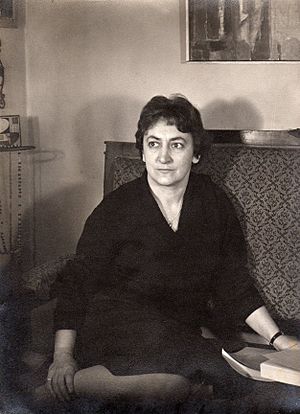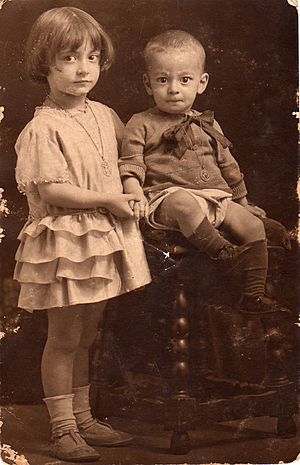Maria Aurèlia Capmany facts for kids
Quick facts for kids
Maria Aurèlia Capmany
|
|
|---|---|

Maria Aurelia Capmany i Farnés
|
|
| Born | 3 August 1918 Barcelona |
| Died | 2 October 1991 (aged 73) Barcelona |
| Language | Catalan and Spanish |
| Nationality | Spanish |
Maria Aurèlia Capmany i Farnés (born August 3, 1918, in Barcelona – died October 2, 1991) was a talented writer from Catalonia, Spain. She wrote many novels, plays, and essays. She was also a strong supporter of women's rights and spoke out against the dictator Francisco Franco.
Maria Aurèlia Capmany wrote a book called Cita de narradors ("Rendezvous of Narrators") in 1958. She wrote it with other famous writers like Manuel de Pedrolo and Joan Perucho. This book won an important award called the Josep Yxart Essay Prize.
Contents
Life and Education
Maria Aurèlia grew up in Barcelona, near a famous street called la Rambla. Her family was very interested in culture and traditions. Her grandfather, Sebastià Farnés, was a scholar who studied old sayings. Her father, Aureli Capmany i Farrés, collected folklore and wrote for children's magazines.
She went to a special school called Institut-Escola de la Generalitat de Catalunya. After a difficult period in Spain's history (the Spanish Civil War), she studied Philosophy at the University of Barcelona.
In the 1940s and 1950s, Maria Aurèlia worked as a teacher. She taught at schools in Badalona and Barcelona. She also learned how to engrave glass at university and did that job too.
Her Writing Career
Maria Aurèlia Capmany started her writing journey with her first novel, Necessitem morir (We Need to Die). It was published in 1952. Before that, in 1947, this book was a finalist for the Joanot Martorell Prize. The very next year, she won that prize with her novel El cel no és transparent (The Sky is Not Transparent).
She became very well-known for novels like Betúlia and El gust de la pols (The Flavour of Dust). Her book Un lloc entre els morts (A Place Among the Dead) won the Sant Jordi Prize in 1968.
Maria Aurèlia was a very flexible writer. She wrote many different kinds of books. She wrote fiction, plays for the theater, and essays. She also translated books from other languages into Catalan.
Plays and Theater
In 1959, Maria Aurèlia helped start a theater school called Escola d'Art Dramàtic Adrià Gual. She worked there as a teacher, an actress, and even a director. She also wrote and put on her own plays. One famous play was Preguntes i respostes sobre la vida i la mort de Francesc Layret advocat dels obrers de Catalunya. This means "Questions and Answers about the Life and Death of Francesc Layret, Lawyer for the Workers of Catalonia."
Writing for Children
Maria Aurèlia also wrote books especially for young people. In 1983, she won the Premi Crítica Serra d'Or de Literatura Infantil i Juvenil for her book El malefici de la reina d'Hongria (The Curse of the Hungarian Queen).
Essays and Women's Rights
As an essay writer, Maria Aurèlia was famous for her books about the lives of women. Her book La dona a Catalunya: consciència i situació (The Woman in Catalonia: Awareness and Situation), published in 1966, was very important.
In the same year, she took part in a big protest called the Caputxinada. This was a meeting against the Spanish dictator Francisco Franco. She also wrote many articles about Catalan culture and society. Her books of memories, like Pedra de toc and Mala memòria, are also well-known.
Public Life and Politics
Maria Aurèlia Capmany was also active in politics. She spoke at the Míting de la Llibertat ("Meeting of Freedom") in 1976. She also helped create the Socialist Party of Catalonia-Congress in November 1976.
From 1983 until her death in 1991, she worked for the city of Barcelona. She was a councillor and was in charge of Culture and publishing for Barcelona's Town Hall. She was also a member of the Diputation of Barcelona.
She was a member of the Associació d'Escriptors en Llengua Catalana (Association of Catalan Language Writers). She was also the president of the Catalan PEN Club, which is part of the international writers' organization PEN International.
Her Works
Maria Aurèlia Capmany wrote many different types of works. Here are some of them:
Novels
- Necessitem morir (We Need to Die) (1952)
- L'altra ciutat (The Other City) (1955)
- Betúlia (1956)
- El gust de la pols (The Flavour of Dust) (1962)
- Un lloc entre els morts (A Place Among the Dead) (1967)
- Feliçment, jo sóc una dona (Happily, I Am a Woman) (1969)
- Lo color més blau (The Bluest Colour) (1983)
Short Stories
- Com una mà (Like a Hand) (1952)
- Cartes impertinents de dona a dona (Impertinent Letters from Woman to Woman) (1971)
- Aquelles dames d'altres temps (Those Ladies of Other Times) (1990)
Literature for Children and Young Adults
- Anna, Bel i Carles (1971)
- Ni teu, ni meu (Neither Yours, Nor Mine) (1972)
- L'alt rei en Jaume (King James the Tall) (1977)
- El malefici de la reina d'Hongria o Les aventures dels tres patrons de nau (The Curse of the Hungarian Queen or The Adventures of the Three Ship Captains) (1982)
- La rialla del mirall (The Mirror's Laughter) (1989)
Plays
- Tu i l'hipòcrita (You and the Hypocrite) (1960)
- Vent de garbí i una mica de por (Southwest Wind and a Little Fear) (1968)
- Preguntes i respostes sobre la vida i la mort de Francesc Layret, advocat dels obrers de Catalunya (Questions and Answers about the Life and Death of Francesc Layret, Lawyer for the Workers of Catalonia) (1970)
Essays
- La dona a Catalunya : consciència i situació (The Woman in Catalonia: Awareness and Situation) (1966)
- Dia sí, dia no : apunts sobre la nostra societat actual (Day Yes, Day No: Notes on Our Current Society) (1968)
- El feminismo ibérico (Iberian Feminism) (1970)
- De profesión mujer (Profession: Woman) (1971)
- En busca de la mujer española (In Search of the Spanish Woman) (1982)
Memoirs
- Pedra de toc (Touchstone) (1970–1974)
- Mala memòria (Bad Memory) (1987)
- Això era i no era (This Was and Was Not) (1989)
Comic Books
- Dona, doneta, donota (Woman, Little Woman, Big Woman) (1979)
Translations
Maria Aurèlia Capmany translated many books from French, Italian, and English. Some of the famous authors she translated include:
- Honoré de Balzac (French)
- Marguerite Duras (French)
- Georges Simenon (French)
- Italo Calvino (Italian)
- Cesare Pavese (Italian)
- James M. Cain (English)
See also
 In Spanish: Maria Aurèlia Capmany para niños
In Spanish: Maria Aurèlia Capmany para niños


